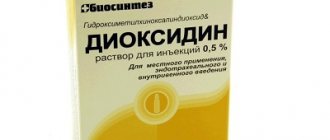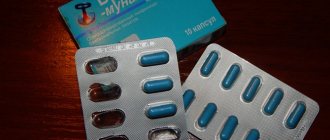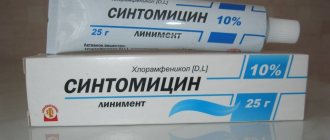Composition and release form
Palin is available in the form of tablets, capsules and vaginal suppositories. Their composition:
| Capsules | Pills | Candles | |
| Description | White capsules with a green cap, yellow powder inside | White round tablets | White torpedo-shaped suppositories |
| Concentration of the active component, mg per piece. | 200 | 400 | 200 |
| Auxiliary components | Gelatin, silicon dioxide, black, blue, quinoline yellow and sunset yellow dyes, starch, titanium dioxide, magnesium stearate | Lactose monohydrate, magnesium stearate, corn starch, colloidal silica | Solid fat |
| Package | Blisters of 10 pcs., 2 blisters in a pack with instructions for use | Bottles of 20 pcs. | Strips 10 pcs. |
| Price, rubles | 250 for 20 pcs. | 230 for 20 pcs. | 200 for 10 pcs. |
Is Palin an antibiotic or not?
The drug Palin is an antibiotic because it contains the antibacterial pipemidic acid. It belongs to the quinolone series of uroantiseptics and has a wide spectrum of action. It is characterized by bacteriostatic and bactericidal effects depending on the concentration and location of microbes. The principle of action of pipemidic acid is to suppress bacterial DNA topoisomerase and DNA gyrase, which take part in repair, transcription and replication of the bacterial cell.
This leads to disruption of processes and further death of the microorganism. Pipemidic acid in Palin exhibits an effect against gram-negative enterobacteria, Proteus, Escherichia coli, Citrobacteria, and Morganella. The drug is moderately active against Klebsiella and Acinobacteria. The remedy is useless against pseudomonas, chlamydia, mycobacteria, Pseudomonas aeruginosa, anaerobic and gram-positive pathogens. Resistance to pipemidic acid develops slowly.
Once inside, the active component is quickly absorbed, has 93% bioavailability, and reaches maximum concentration after an hour and a half. Pipemidic acid binds to proteins by 30%, is excreted unchanged by the kidneys (up to 85% of the dose is excreted on the first day) and with feces. The highest concentration of the active substance is observed in urine, prostate secretions, and kidneys. It passes through the membranes of the brain and enters breast milk.
Pharmacokinetics
Suction
After taking the drug orally at a dose of 400 mg, the Cmax of pipemidic acid is reached after 70-80 minutes and is 3.5 μg/ml. Bioavailability is 30-60%.
Distribution
High concentrations of pipemidic acid are created in the kidneys, urine and prostate fluid.
Pipemidic acid penetrates the placental barrier. Excreted in breast milk in small quantities.
Removal
Pipemidic acid is mainly excreted unchanged in the urine. 50-85% of the administered dose of the drug is determined in daily urine. The excretion of pipemidic acid is directly dependent on creatinine clearance. T1/2 is 2 hours 15 minutes. Total clearance - 6.3 ml/min.
Pharmacokinetics in special clinical situations
In patients with impaired renal function, higher concentrations of the drug in the blood plasma are observed than in healthy volunteers.
T1/2 is 5.7-16 hours.
How to take Palin
Depending on the form of release of the product, its method of application differs. Tablets and capsules are taken orally, suppositories are taken intravaginally. According to urologists, the use of Palin for cystitis is possible only in uncomplicated forms of acute and chronic disease, because microorganisms have already developed resistance to the effects of the drug. The drug can be used as a reserve if the patient cannot use more modern drugs (Monural, Xenavin, Tsifran).
Palin is used to treat uncomplicated forms of pyelonephritis. Before therapy, it is necessary to study the sensitivity of microorganisms to the drug by examining urine using bacteriological culture. In the first three days of treatment, the usual dosage of the drug is prescribed, after which the result is assessed. In total, therapy lasts about 3–6 weeks, periodically a urine test is performed and the sensitivity of the pathogen is checked.
According to the instructions, there are no reports of serious side effects or deaths from an overdose of Palin. Symptoms of exceeding the dose of the drug are nausea, vomiting, convulsions, dizziness, headache, tremor, confusion. The antidote to the medicine is unknown. The patient's stomach is washed, activated charcoal is given, and if convulsions occur, Dizaepam is administered.
Capsules
According to the instructions, Palin capsules are taken in the morning and evening before meals in a dosage of 200 mg. If the patient has staphylococcal lesions of the urinary tract, then no more than eight hours should pass between doses of the drug. The course of therapy lasts on average 1.5 weeks. If necessary, it is increased. For kidney damage, the course lasts 1.5 months, for prostate inflammation - 2 months. During treatment you need to drink more water.
Pills
The medicine in tablet format is taken orally, without chewing, with a glass of water. During treatment, the patient is supposed to take at least 2 liters of water per day and monitor the amount of urine excreted. Palin is prescribed in the amount of 200 mg twice a day with an interval of 12 hours; for staphylococcal infections, take 200 mg three times a day every 8 hours. The average course of treatment is 10 days, if necessary lasts up to 6–8 weeks. In case of severe damage to kidney or liver function, the dose is adjusted.
Suppositories
In addition to the systemic use of Palin tablets or capsules, vaginal suppositories are used. They can only be used by women - one every day (at night). The course of treatment with vaginal suppositories lasts no longer than 7–10 days. If necessary, it will be extended. This is done by the attending doctor, based on the symptoms and course of the disease.
Palin - overdose
There are no reports of serious side effects or death following an overdose of the drug. Symptoms: nausea, vomiting, dizziness, headache, confusion, tremors, convulsions. Treatment: there is no specific antidote. If less than 4 hours have passed since taking the medicine, to reduce absorption it is necessary to rinse the stomach followed by the administration of activated charcoal. If side effects from the central nervous system (including epileptiform convulsions) develop, symptomatic treatment (diazepam) is prescribed. The elimination of the drug can be accelerated using forced diuresis.
special instructions
The instructions for use of Palin contain special instructions for its use:
- The drug is used with caution in people over 70 years of age, with a history of seizures, changes in cerebral circulation, allergic reactions to quinolones (cross-sensitivity may develop).
- During treatment, do not be exposed to ultraviolet or solar radiation because photosensitivity is possible.
- With long-term therapy with the drug, the functions of the kidneys and liver should be regularly examined, and biochemical and general blood tests should be done.
- During treatment, you should stop driving a car and operating machinery.
- During therapy, a false-positive urine reaction to glucose may be observed when using Felling's solution or Benedict's reagent. To exclude false results, it is recommended to use enzymatic reactions based on glucose oxidase.
- When treated with pipemyldic acid, superinfections caused by bacteria and fungi that are insensitive to it may develop.
- When diarrhea occurs, there is a risk of developing pseudomembranous colitis, so you need to take therapeutic measures.
- The drug is not recommended for patients with porphyria (due to the risk of developing an acute porphyrin crisis against the background of the porphyrinogenic effect of the active component) and with glucose-6-phosphate dehydrogenase deficiency (an acute hemolytic crisis may develop).
- The capsule shell contains brilliant black dye, which can cause allergic reactions and asthma. This often occurs due to hypersensitivity to acetylsalicylic acid.
Reviews about Palin
There are many positive and negative opinions among patient reviews. If in proportion, then the first are about 40%, while the others are negative - 60%. Positive reviews are left by those for whom the medicine has helped. The drug did not lead to the development of side effects and relieved urethritis, cystitis or prostatitis.
Patient review
Negative reviews are associated with the development of side effects. As practice shows, they develop frequently. Patients mainly complained of stomach pain, stool disturbances, nausea, migraines and dizziness.
Some patients believe that the low cost of the drug Palin indicates low effectiveness, and there are more modern drugs that work better, faster, and are less likely to cause side effects.
Palin during pregnancy
According to the instructions, there is no information about the safety and effectiveness of using Palin during pregnancy, therefore, the drug is not prescribed in any form during pregnancy. Pipemidic acid penetrates the placenta and breast milk, and from there it can enter the newborn’s body, therefore, during lactation, antibiotic treatment is prohibited, even in the form of suppositories.
Contraindications
Before taking Palin, it is necessary to take into account a number of contraindications, which lead to a categorical ban on treatment with this drug. This is another reason why it is necessary to see a doctor. Since the contraindications are very serious, this point should never be ignored.
- First of all, it is a violation of kidney function. Palin is prohibited when creatine clearance, that is, the rate at which blood passes through the kidneys, is below 10 ml/min. Naturally, this figure can only be found out through special research, that is, from a doctor.
- Any disturbances in the functioning of the liver are also a contraindication.
- The drug should not be used in children under any circumstances until they reach the age of 14 years.
- It is strictly forbidden to take the product during pregnancy and breastfeeding, since it penetrates the baby’s body.
- Allergy to its individual components.
- If a person taking the drug complains of any negative symptoms, it is necessary to abandon it and choose a different treatment regimen.
Unfortunately, some people do not take the list of contraindications seriously, believing that they can tolerate it for 10 years. In fact, this is a huge stupidity that can cost a person his health.
It is necessary to tell your doctor about all your known diseases and disorders so that he can make the right decision.
You should also not be shy and should immediately visit a specialist if any strange reactions occur while taking the drug. Each organism is unique, and it is very difficult to predict exactly how it will interact with a particular drug.
You must tell your doctor about all your known diseases and disorders.
Drug interactions
The instructions for use of Palin talk about drug interactions between the drug and other drugs. Examples and consequences:
- Antacids (against acidity based on aluminum, calcium, magnesium) and sucralfate can reduce the absorption of pipemidic acid in the digestive tract. If it is necessary to use them together, a 2-3 hour interval is maintained, except for Cimetidine and Ranitidine.
- Long-term simultaneous use of Palin and Theophylline or caffeine increases the concentration of the latter in the blood.
- The drug enhances the effects of Rifampicin, non-steroidal anti-inflammatory drugs, Warfarin, Cimetidne.
- The combination of the drug with antibiotics from the aminoglycoside group increases the bactericidal effect (synergistic effect).
- Concomitant use of Palin with other quinolones or non-narcotic painkillers leads to a risk of developing seizures.
Instructions for use
Palin is widely used to treat acute and chronic diseases of the genitourinary system caused by pathogenic bacteria, including cystitis, pyelonephritis, urethritis, vaginitis, prostatitis, vulvitis. The treatment regimen depends on several factors, including: diagnosis, stage of development and severity of the disease, and resistance of the pathogen. The daily dose of Palin for cystitis is 800 mg. In some cases, it is increased to 1200 mg per day.
- For cystitis in the acute phase, you need to take one capsule in the morning and evening for 5-7 days.
- For cystitis in the chronic stage, you need to take one capsule in the morning and evening for 7-10 days in combination with other antibiotics.
- Prevention to prevent recurrence of cystitis consists of taking Palin 2 times a day for 2 days.
You should drink plenty of fluids while undergoing treatment. You should not be in direct sunlight after consuming Palin due to the increased risk of photosensitivity.
Side effects
During treatment with Palin, side effects often occur. The instructions indicate possible reactions:
- hemolytic anemia (lack of hemoglobin), thrombocytopenia (impaired functioning of platelets and red blood cells), eosinophilia (decreased level of leukocytes);
- seizures, headache, convulsions, tremors, sensory disturbances, visual disturbances, hallucinations, insomnia, depression, agitation, nightmares, drowsiness, confusion, trembling;
- vomiting, gastralgia, diarrhea, nausea, colitis, heartburn, flatulence, loss of appetite, intestinal upset;
- urticaria, allergies, Stevens-Johnson syndrome, itching, anaphylactic shock;
- photosensitivity;
- resistance, superinfection.
Analogs
You can replace the drug with products with a similar effect, the same or a different composition. Palin's analogues are:
- Ciprofloxacin – antimicrobial tablets and injection solution based on ciprofloxacin lactate;
- Tsiprolet - antimicrobial substances: injection solution and tablets containing ciprofloxacin monohydrate hydrochloride;
- Ofloxacin – bactericidal tablets and solution for infusion with the same active ingredient;
- Cifran - antibacterial tablets based on ciprofloxacin.











